Get Stronger Without Moving: 5 Static Exercises That Burn Fat and Build Muscle
![]()
Working out is associated with movement, motion and activity. Chilling out is associated with idleness and inaction. Oftentimes, your level of exercise is measured by how far you move. How many times has a friend said something along the lines of “I ran 6 miles yesterday!” or “I biked all the way home”? The same goes for levels inactivity, when you hear phrases like “I didn’t leave my bedroom this weekend” or “I binge-watched Game of Thrones for nine hours straight on the couch”—stuff that’s synonymous with laziness.
But working out doesn’t always require movements like running, jumping, sprinting, pushing and pulling. In fact, working out can require nothing more than remaining still. Isometric exercises—i.e., those where the affected joints don’t move and the involved muscles don’t noticeably change length—require you to hold a challenging position for an extended period of time. While the majority of your workouts should consist of eccentric and concentric movements, isometric exercises can help you build muscle, burn fat and prevent injuries. For a fresh physical and mental challenge, try one of these static exercises next time you hit the gym.
Dumbbell Holds
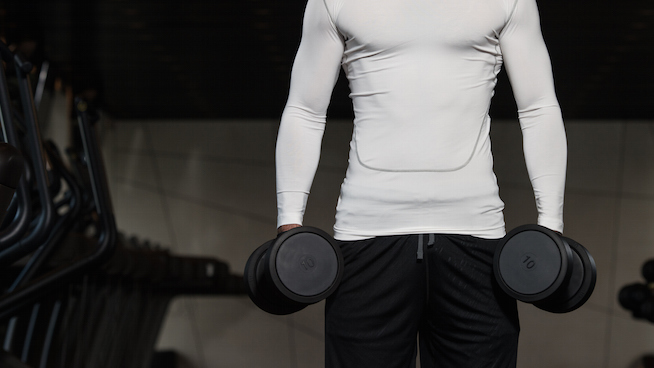
Dumbbell Holds are a deceptively simple exercise. But if you think simple means easy, you’re in for a rude awakening. Dumbbell Holds challenge nearly every muscle in your arms, and they’re a great way to build grip strength. Grip strength is useful for more than firm handshakes. It plays a role in almost every sport. Pulling down a rebound, hitting a baseball, battling for a puck in the corner—these are all plays where grip strength can help you succeed. Dumbbell Holds will torch your arms and push your grip to the limit, so you might be best served by saving them for the end of your workout.
Dumbbell Holds can be done either by grabbing the bar part of the dumbbells, so the dumbbells are parallel to the floor, or by actually gripping the thick head of the dumbbells with an open hand, so that they’re perpendicular to the floor. The latter position is more difficult and will really test the strength of your fingers.
How-To: Grab a pair of heavy dumbbells and hold them by your side. Keeping your core tight, your arms still and your eyes straight ahead, hold the dumbbells in place for either one minute or until failure. Experiment with different dumbbells until you find a weight that is challenging but that allows you to hold them for an extended period of time. Perform two to three sets.
Isometric Deadlifts
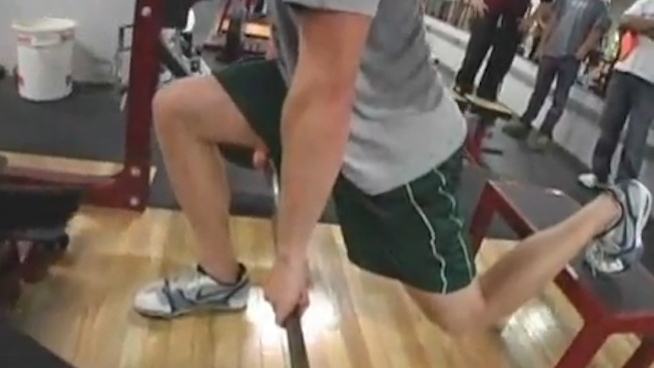
The Isometric Deadlift is an exercise that can quickly improve your lower body strength and flexibility. It’s a combination of a standard Deadlift and an Elevated Split-Squat.
This challenging exercise might feel like a lunge from hell, but the rewards include stronger quads, glutes and hamstrings. Cal Dietz, a strength and conditioning coach at the University of Minnesota who uses it with his athletes, says, “It’s one of the best exercises for getting an athlete strong. I’ve seen athletes change their entire running form when they run agilities, because they are stronger within two weeks. I’ve never seen athletes get better faster from any other lift.”
Though Squats and Deadlifts should make up the majority of your lower body routine, Isometric Deadlifts are a great way to mix things up and challenge your body in a new way.
How-To: Assume a split-stance with your right leg forward on the ground and your rear leg resting on a box or bench. Have a barbell on the ground directly under your hips and pins attached to a rack on either side of you. Lower to grasp the barbell with an overhand grip. Contract your quads and glutes to raise the bar until it hits the pins while trying to keep your hips, knees and the bar in a straight line. Your front knee should be at about a 90-degree angle and your shoulders should be back. Hold the top position for three reps of 7-10 seconds on both legs, resting about 2 minutes between sets. The Isometric Deadlift is easier to understand when you actually see it, so check out this video to view it in action.
Planks
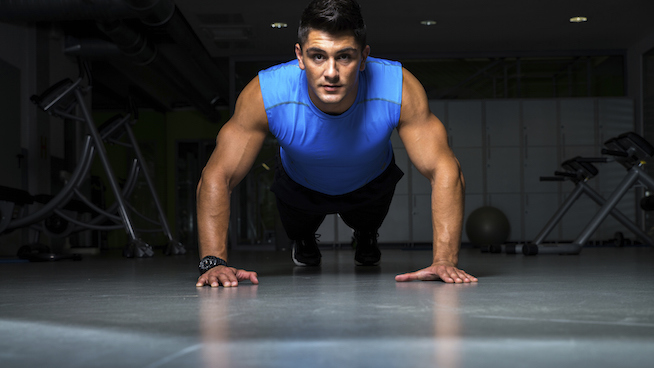
The Plank is probably the most common isometric exercise there is. Planks are a great way to engage your entire core, and they are incredibly efficient. Just a few minutes of holding a Plank will have your mid-section begging for mercy. In what had to be one of the most boring world records to witness in person, a Chinese police officer recently set the record for holding a Plank for 4 hours and 26 minutes!
The basic Plank is an awesome exercise, and a plethora of variations are worth a try. Side Planks, BOSU Planks and Rope Planks are all unique twists that challenge your core in new and exciting ways.
How-To: The basic Plank is a simple movement. Begin in a push-up position. Bend your elbows at 90 degrees and rest your weight on your forearms. Keep your core tight and your back flat. Hold for 1-2 minutes and perform for three sets.
RELATED: The Hardest Plank of All Time
Pull-Up Holds
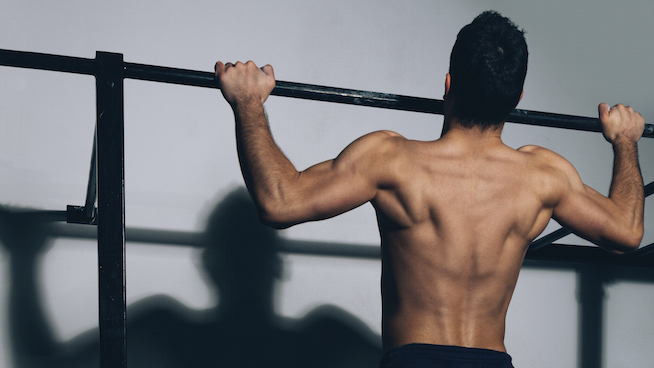
Pull-Ups are one of our favorite exercises for building upper-body strength. A unique variation is an exercise known as Pull-Up Holds. By holding the top position of the Pull-Up for an extended period of time, you’ll test both your upper-body strength and flexibility. Pull-Up Holds, a.k.a. Isometric Pull-Ups, are simple yet effective.
If you cannot yet perform multiple Pull-Ups, doing Pull-Up Holds for a short period of time could help you increase your reps. If you’ve already mastered the basic Pull-Up, this is a fun and challenging variation. Pull-Up Holds will not only increase your upper-body strength, they can actually help you correct poor, slouching posture due to the fact they require your shoulders to be pulled back.
How-To: Get into the top of the Pull-Up position by either pulling yourself into it or stepping up via a box or rack. Your palms should be facing away from you, and your hands should be 3-4 inches wider than shoulder-width. At the top of the position, pull your shoulder blades back and down as if you’re trying to push the top of your chest through the bar. Keep your core tight and your neck in line with your spine while you hold that position. At first, hold the position for as long as possible, taking breaks when needed and aiming to achieve 30 total seconds in the top position. Once you’ve mastered that, shoot for 30 consecutive seconds in the top position.
Wall Sits
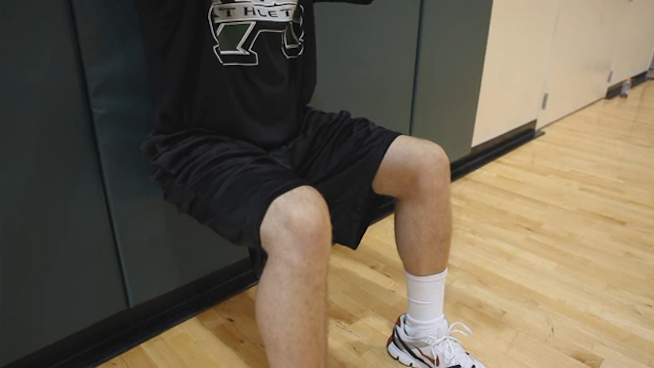
Like many of the exercises on this list, the effectiveness of Wall Sits might not be immediately apparent. They look like you’re just leaning against a wall. That can’t be a real exercise, right?
Well, looks can be deceiving. Anyone who ever performed a Wall Sit for an extended amount of time knows the leg-shaking, muscle-aching pain they can induce. Wall Sits are great for building muscle endurance, which is crucial for late game situations.
How-To: Sit against a wall with your thighs parallel to the floor. Keep your heels flat on the ground and your back straight against the wall. Your feet should be about shoulder-width apart or slightly wider. Either hold your arms out in front of you or keep them by your sides. Begin by seeing if you can hold a Wall Sit for a full minute, then work your way up to 2+ minutes for two sets. Throw on a weighted vest or hold a plate to increase the difficulty.
RECOMMENDED FOR YOU
MOST POPULAR
Get Stronger Without Moving: 5 Static Exercises That Burn Fat and Build Muscle
![]()
Working out is associated with movement, motion and activity. Chilling out is associated with idleness and inaction. Oftentimes, your level of exercise is measured by how far you move. How many times has a friend said something along the lines of “I ran 6 miles yesterday!” or “I biked all the way home”? The same goes for levels inactivity, when you hear phrases like “I didn’t leave my bedroom this weekend” or “I binge-watched Game of Thrones for nine hours straight on the couch”—stuff that’s synonymous with laziness.
But working out doesn’t always require movements like running, jumping, sprinting, pushing and pulling. In fact, working out can require nothing more than remaining still. Isometric exercises—i.e., those where the affected joints don’t move and the involved muscles don’t noticeably change length—require you to hold a challenging position for an extended period of time. While the majority of your workouts should consist of eccentric and concentric movements, isometric exercises can help you build muscle, burn fat and prevent injuries. For a fresh physical and mental challenge, try one of these static exercises next time you hit the gym.
Dumbbell Holds

Dumbbell Holds are a deceptively simple exercise. But if you think simple means easy, you’re in for a rude awakening. Dumbbell Holds challenge nearly every muscle in your arms, and they’re a great way to build grip strength. Grip strength is useful for more than firm handshakes. It plays a role in almost every sport. Pulling down a rebound, hitting a baseball, battling for a puck in the corner—these are all plays where grip strength can help you succeed. Dumbbell Holds will torch your arms and push your grip to the limit, so you might be best served by saving them for the end of your workout.
Dumbbell Holds can be done either by grabbing the bar part of the dumbbells, so the dumbbells are parallel to the floor, or by actually gripping the thick head of the dumbbells with an open hand, so that they’re perpendicular to the floor. The latter position is more difficult and will really test the strength of your fingers.
How-To: Grab a pair of heavy dumbbells and hold them by your side. Keeping your core tight, your arms still and your eyes straight ahead, hold the dumbbells in place for either one minute or until failure. Experiment with different dumbbells until you find a weight that is challenging but that allows you to hold them for an extended period of time. Perform two to three sets.
Isometric Deadlifts

The Isometric Deadlift is an exercise that can quickly improve your lower body strength and flexibility. It’s a combination of a standard Deadlift and an Elevated Split-Squat.
This challenging exercise might feel like a lunge from hell, but the rewards include stronger quads, glutes and hamstrings. Cal Dietz, a strength and conditioning coach at the University of Minnesota who uses it with his athletes, says, “It’s one of the best exercises for getting an athlete strong. I’ve seen athletes change their entire running form when they run agilities, because they are stronger within two weeks. I’ve never seen athletes get better faster from any other lift.”
Though Squats and Deadlifts should make up the majority of your lower body routine, Isometric Deadlifts are a great way to mix things up and challenge your body in a new way.
How-To: Assume a split-stance with your right leg forward on the ground and your rear leg resting on a box or bench. Have a barbell on the ground directly under your hips and pins attached to a rack on either side of you. Lower to grasp the barbell with an overhand grip. Contract your quads and glutes to raise the bar until it hits the pins while trying to keep your hips, knees and the bar in a straight line. Your front knee should be at about a 90-degree angle and your shoulders should be back. Hold the top position for three reps of 7-10 seconds on both legs, resting about 2 minutes between sets. The Isometric Deadlift is easier to understand when you actually see it, so check out this video to view it in action.
Planks

The Plank is probably the most common isometric exercise there is. Planks are a great way to engage your entire core, and they are incredibly efficient. Just a few minutes of holding a Plank will have your mid-section begging for mercy. In what had to be one of the most boring world records to witness in person, a Chinese police officer recently set the record for holding a Plank for 4 hours and 26 minutes!
The basic Plank is an awesome exercise, and a plethora of variations are worth a try. Side Planks, BOSU Planks and Rope Planks are all unique twists that challenge your core in new and exciting ways.
How-To: The basic Plank is a simple movement. Begin in a push-up position. Bend your elbows at 90 degrees and rest your weight on your forearms. Keep your core tight and your back flat. Hold for 1-2 minutes and perform for three sets.
RELATED: The Hardest Plank of All Time
Pull-Up Holds

Pull-Ups are one of our favorite exercises for building upper-body strength. A unique variation is an exercise known as Pull-Up Holds. By holding the top position of the Pull-Up for an extended period of time, you’ll test both your upper-body strength and flexibility. Pull-Up Holds, a.k.a. Isometric Pull-Ups, are simple yet effective.
If you cannot yet perform multiple Pull-Ups, doing Pull-Up Holds for a short period of time could help you increase your reps. If you’ve already mastered the basic Pull-Up, this is a fun and challenging variation. Pull-Up Holds will not only increase your upper-body strength, they can actually help you correct poor, slouching posture due to the fact they require your shoulders to be pulled back.
How-To: Get into the top of the Pull-Up position by either pulling yourself into it or stepping up via a box or rack. Your palms should be facing away from you, and your hands should be 3-4 inches wider than shoulder-width. At the top of the position, pull your shoulder blades back and down as if you’re trying to push the top of your chest through the bar. Keep your core tight and your neck in line with your spine while you hold that position. At first, hold the position for as long as possible, taking breaks when needed and aiming to achieve 30 total seconds in the top position. Once you’ve mastered that, shoot for 30 consecutive seconds in the top position.
Wall Sits

Like many of the exercises on this list, the effectiveness of Wall Sits might not be immediately apparent. They look like you’re just leaning against a wall. That can’t be a real exercise, right?
Well, looks can be deceiving. Anyone who ever performed a Wall Sit for an extended amount of time knows the leg-shaking, muscle-aching pain they can induce. Wall Sits are great for building muscle endurance, which is crucial for late game situations.
How-To: Sit against a wall with your thighs parallel to the floor. Keep your heels flat on the ground and your back straight against the wall. Your feet should be about shoulder-width apart or slightly wider. Either hold your arms out in front of you or keep them by your sides. Begin by seeing if you can hold a Wall Sit for a full minute, then work your way up to 2+ minutes for two sets. Throw on a weighted vest or hold a plate to increase the difficulty.












